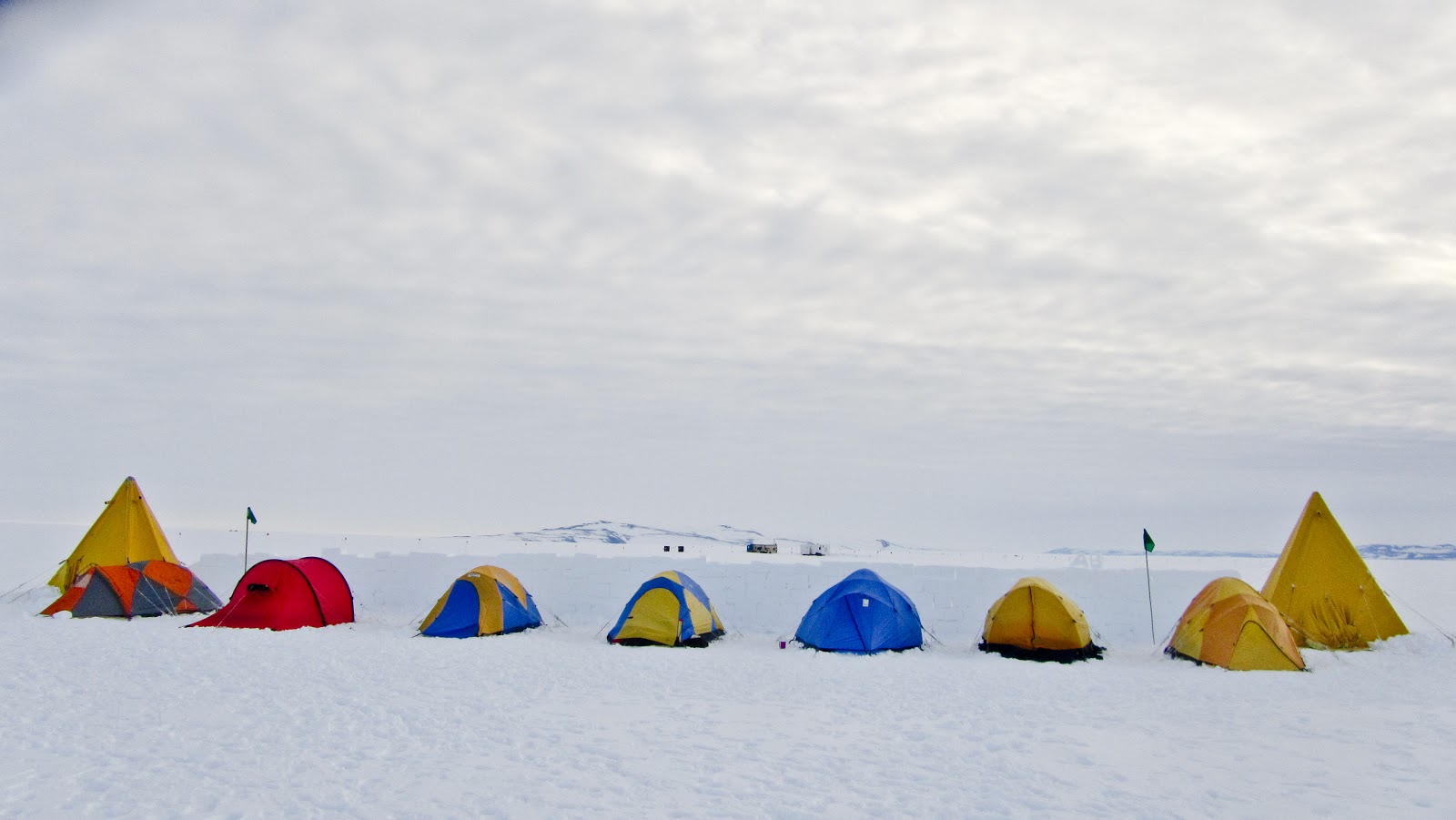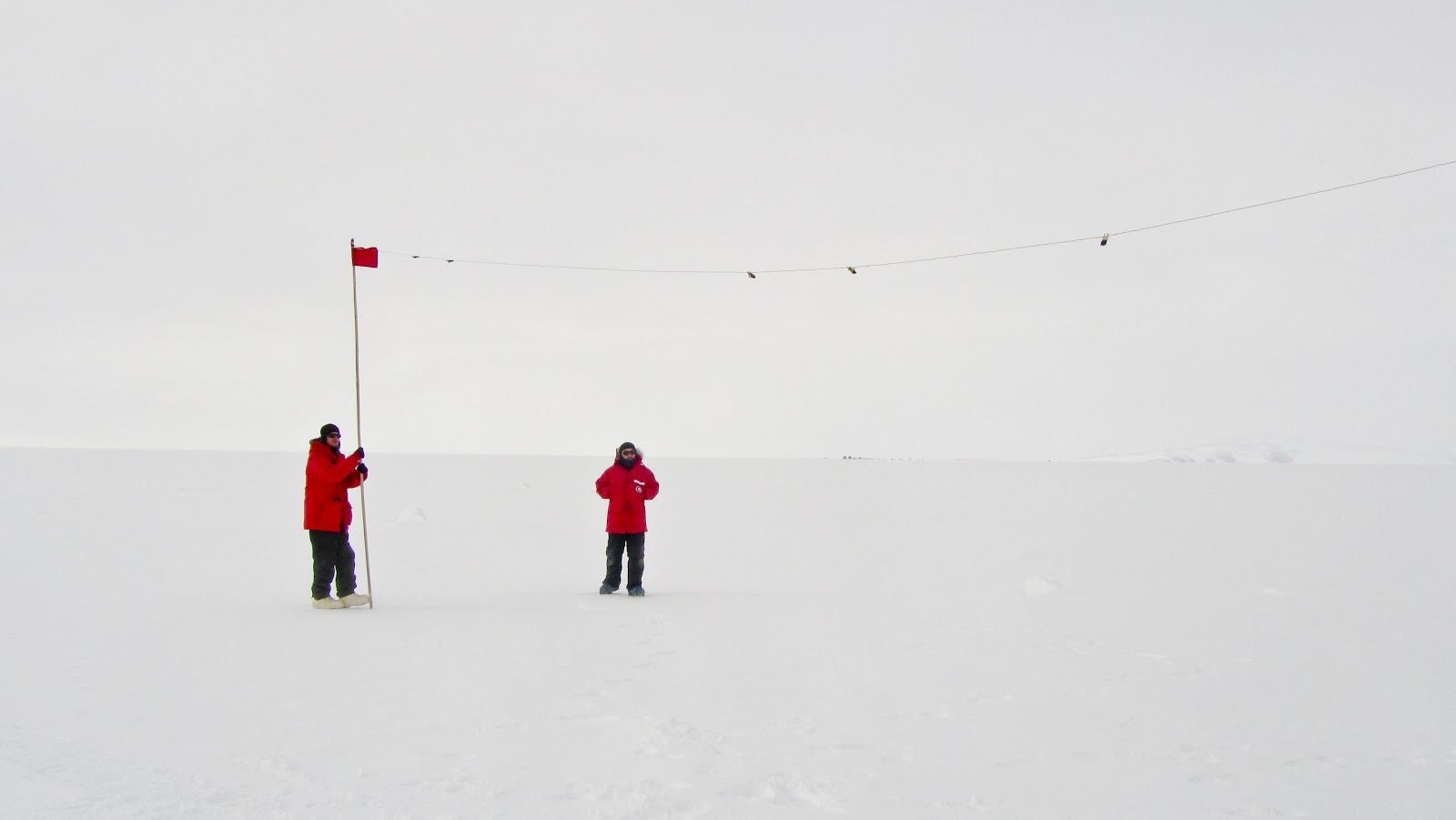There is one cooler in the kitchen that stores all of the "freshies" (fresh foods like salad stuff, fruits, cheese, etc.). Freshies only arrive every so often and so it is sort of a big deal when they do. I went into this cooler to retrieve some items.....and may or may not have farted. I fled the scene before anyone arrived so I can't be blamed for an inevitable pink eye pandemic.
I am so sorry.
Thursday, November 29, 2012
Guiding the Pressure Ridges
Close to the Kiwi Base are beautiful and majestic ice formations shooting up from the surface of the sea ice. These are called Pressure Ridges and we find ourselves there a few times a week guiding other McMurdo residents through the eerie glacier turquoise behemoths of ice.
| The Thumbs UP! |
Pressure Ridges are formed between the forces exerted from the ice shelf on the more variable sea ice. The permanent ice shelf is actually a massive floating glacier on top of the sea. Some estimates we have heard is that the Ross Ice Shelf is about 1,000 feet thick. The sea ice is found closer to shore and is not permanent. This sea ice ebbs with the changing seasons and is currently 6 or 7 feet thick and will almost completely break up and melt by January. As the massive ice shelf exerts pressure on the sea ice it gives and forms fissures that shove ice up into ridges, thus called Pressure Ridges. This same force mimics how mountain ranges are born on a much faster and smaller scale. These ridges often have cracks in the vicinity due to the changing nature and thickness of the sea ice along with melt pools. The melt pools can be fresh water, salt water, or a brackish mix depending on if they are formed by the melting water off the ridges, fed from a crack leading to the sea, or a mix of both.
Walking among the pressure ridges is an eye opening experience when you consider it through the eyes of Antarctic history and Shackleton's Endurance expedition. Shackleton, on his third expedition to Antarctica, was attempting to land his ship the Endurance on the Antarctic Peninsula (closest to South America). He then was going to travel overland with dog sleds making it to the South Pole and continuing the traverse to arrive back at the Ross Sea, where McMurdo is currently located. He was planning on having a second crew land at Discovery Hut (Scott's hut from previous Antarctic expeditions and still standing next to McMurdo) and take a second team to stash food caches along the way for Shackleton to use to complete his traverse. Shackleton never made it that far and ran into horrible sea conditions unique to sea travel around Antarctica and especially the Weddell Sea. The formation of the Weddell Sea and the surrounding land masses created a dangerous situation. The pack ice trapped the boat between broken ice and icebergs. The Endurance was trapped in the pack ice for months and his crew lived in the boat. Once the end of winter came, the pressure exerted from the ice shelf on the sea ice caused pressure ridges, which eventually encapsulated the boat and destroyed it completely. Shackleton and the rest of his crew were forced to travel over the precarious pack ice dragging their smaller open boats and food on dog sleds over and around the pressure ridges. Navigation was difficult and the ridges of ice made travel slow and tedious. Walking among them today really makes you appreciate the adventure and determination it must have taken long ago Antarctic explorers on such a harsh and unforgiving continent.
| Pretending to be on Shackleton's expedition |
We don't have it quite so rough! We simply take a group of 10 to walk a flagged route and take pictures. The route is constantly changing due to new pressure ridges forming, cracks widening, and expanding melt pools as the season progresses. But sometimes I like to pretend that we're lost. Sometimes the group doesn't like that...just kidding!
If you would like to read more about Shackleton and Antarctica, check out Endurance: Shackleton's Incredible Voyage by Alfred Lansing. Amazing read and an incredible example of leadership.
| Mt. Erebus in the background |
| Pressure Ridges |
| Someone flying a kite in the background |
| Castle Rock to the far left, Mt. Erebus and the smoking plume from the volcano in back, and a melt pool. |
| Weddell Seals |
Only in Antarctica Part Deux
Back by popular demand (by us), here are some more fun, weird, and interesting facts about life in Antarctica:
Fata Morgana: The fata morgana is a type of "superior mirage" appearing right above the horizon line. It is caused when the light has to pass through different temperature layers, thus compressing and stretching the light rays. In polar regions on very cold days, the fata morgana can sometimes be seen when looking across ice sheets. We often see this mirage across the Ross Ice Shelf towards the Royal Society Mountains. In this picture, the ice edge meets what appears to be very vertical cliffs at the horizon line and above are the mountains. Those cliffs are a mirage and that image is being stretched to appear as cliffs. We have seen the same thing happen when a vehicle drove across the horizon line and the vehicle looked like a moving two story building! Note: Chris and I can never remember the name Fata Morgana so we usually refer to it as the "mufasa francheesie".
Life in the 90's: As most of you could guess, there is no cell phone service down here in Antarctica, but communication is not dead. Nope, far from it. Here at McMurdo it is common to hear someone call to a friend, "Hey page me when you need the key". Zack Morris would be very happy to find out that pagers are still a thriving means of communication here at McMurdo. So is paging someone "boobs" during a meeting. I'm just waiting for when Tomagotchi's make their comeback since we don't have pets here either:)
"Extra building materials? Check Fu Manchu": Equipment and materials that do not need to be stored in a reasonable environment are simply stored outdoors. There are aisles and aisles of materials and equipment. Construction materials, tools, extra parts for equipment that hasn't been used since the 70's....everything. Most places use a simple letters/numbers system for easy organization. Keeping things interesting and fun is an important part of McMurdo culture, so a simple letters/numbers system would not suffice. In one area of storage each aisle is called a stash and to distinguish between the different stashes they are named after mustache (or 'stache) styles.
Monday, November 26, 2012
Happy Camper!!!!
About two weeks ago I was lucky enough to have an opportunity to participate in the "Happy Camper" snow course, the same class Carolyn took the week prior. It was an absolute blast and I'd do it again in a heartbeat! Carolyn described the course in her post and so I'll skip that, on to some pics!!!
Gobble Gobble...Happy Turkey Day
Happy Thanksgiving from Antarctica! Today was a bit of a long day for us but we had a great time. We had a fun day celebrating our holiday beginning with a 5km Turkey Trot race around base. We lucked out with beautiful weather, a warm 28 degrees F, with little wind and beautiful blue skies. The route started at the Chapel of the Snows and went along the road leading to the New Zealand base and then back again. We had great views of Mt. Erebus while running and Chris even had a skua fly into him at the start of the race! We then stayed up to our 1 am to celebrate Thanksgiving with our co-workers that work daytime hours. We missed everyone back home and hope that you all had a lovely day celebrating with your families and friends! Gobble Gobble!
| NIGHT SHIFT CREW!!!! |
Trail Dayz!
A week ago, we participated in a day of trail work here at McMurdo. We spent the afternoon on the Observation Hill Loop trail shoveling snow off of the steeper sections. After a summer of trail work with the Montana Conservation Corps, it felt great to be back with tools in our hands, only this time in Antarctica.
| MCC pride:) |
Subscribe to:
Posts (Atom)








